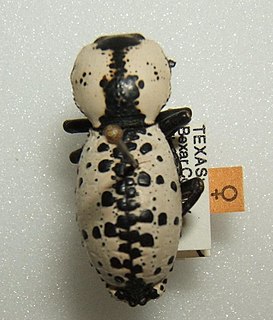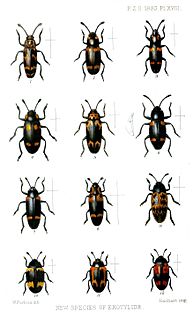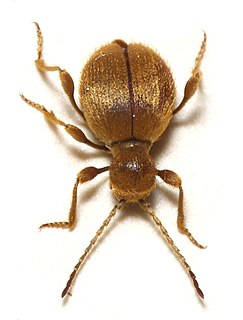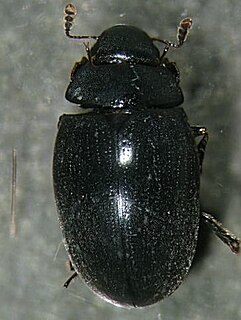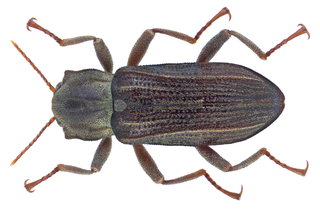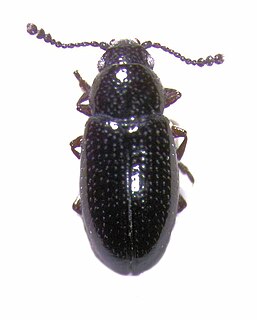| Europs | |
|---|---|
| Scientific classification | |
| Kingdom: | |
| Phylum: | |
| Class: | |
| Order: | |
| Suborder: | |
| Family: | |
| Genus: | Europs Wollaston, 1854 |
Europs is a genus of beetles in the family Monotomidae, containing the following species: [1]

Beetles are a group of insects that form the order Coleoptera, in the superorder Endopterygota. Their front pair of wings are hardened into wing-cases, elytra, distinguishing them from most other insects. The Coleoptera, with about 400,000 species, is the largest of all orders, constituting almost 40% of described insects and 25% of all known animal life-forms; new species are discovered frequently. The largest of all families, the Curculionidae (weevils) with some 80,000 member species, belongs to this order. Found in almost every habitat except the sea and the polar regions, they interact with their ecosystems in several ways: beetles often feed on plants and fungi, break down animal and plant debris, and eat other invertebrates. Some species are serious agricultural pests, such as the Colorado potato beetle, while others such as Coccinellidae eat aphids, scale insects, thrips, and other plant-sucking insects that damage crops.
Monotomidae is a family of beetles in the suborder Polyphaga, containing the following genera:
- Europs alutacea Champion, 1924
- Europs amabilis Grouvelle, 1899
- Europs apicalis Reitter, 1872
- Europs bilineatus Sharp, 1900
- Europs birmanica Grouvelle, 1897
- Europs brevis Grouvelle, 1896
- Europs calognathus Grouvelle, 1914
- Europs chilensis Grouvelle, 1896
- Europs cognatus Sharp, 1900
- Europs corticinus Grouvelle, 1896
- Europs crenicollis Grouvelle, 1906
- Europs depressus Grouvelle, 1896
- Europs diffusus Sharp, 1900
- Europs discedens Sharp, 1900
- Europs duplicatus Wollaston, 1862
- Europs euplectoides Sharp, 1900
- Europs fallax Grouvelle, 1902
- Europs fervida Blatchley, 1928
- Europs flavidus Bousquet, 2003
- Europs foveicollis Grouvelle & Raffray, 1908
- Europs frontalis Grouvelle, 1896
- Europs frugivorus Blatchley, 1928
- Europs germari Reitter, 1876
- Europs gestroi Grouvelle, 1906
- Europs horni Grouvelle, 1908
- Europs illaesus Sharp, 1900
- Europs impressicollis Wollaston, 1854
- Europs impressus Grouvelle, 1896
- Europs indica Grouvelle, 1903
- Europs kolbei Grouvelle, 1908
- Europs longulus Sharp, 1900
- Europs luridipennis (Reitter, 1876)
- Europs maculatus Grouvelle, 1896
- Europs mariae Grouvelle, 1906
- Europs multipunctatus Grouvelle, 1908
- Europs nanus Sharp, 1900
- Europs obtusus Sharp, 1900
- Europs oxytela Sharp, 1900
- Europs pallipennis (LeConte, 1861)
- Europs pumilio Sharp, 1900
- Europs raffrayi Grouvelle, 1896
- Europs rhizophagoides Reitter, 1872
- Europs simplex Sharp, 1900
- Europs sordidus Grouvelle, 1896
- Europs striatulus Fall in Fall & Cockerell, 1907
- Europs sulcicollis Bousquet, 2003
- Europs temporis Reitter, 1884
- Europs vicinus Grouvlle, 1896
- Europs wollastoni Reitter, 1872
- Europs zonatus Grouvelle, 1902
Europs pallipennis is a species in the family Monotomidae, in the suborder Polyphaga . It is found in North America.
